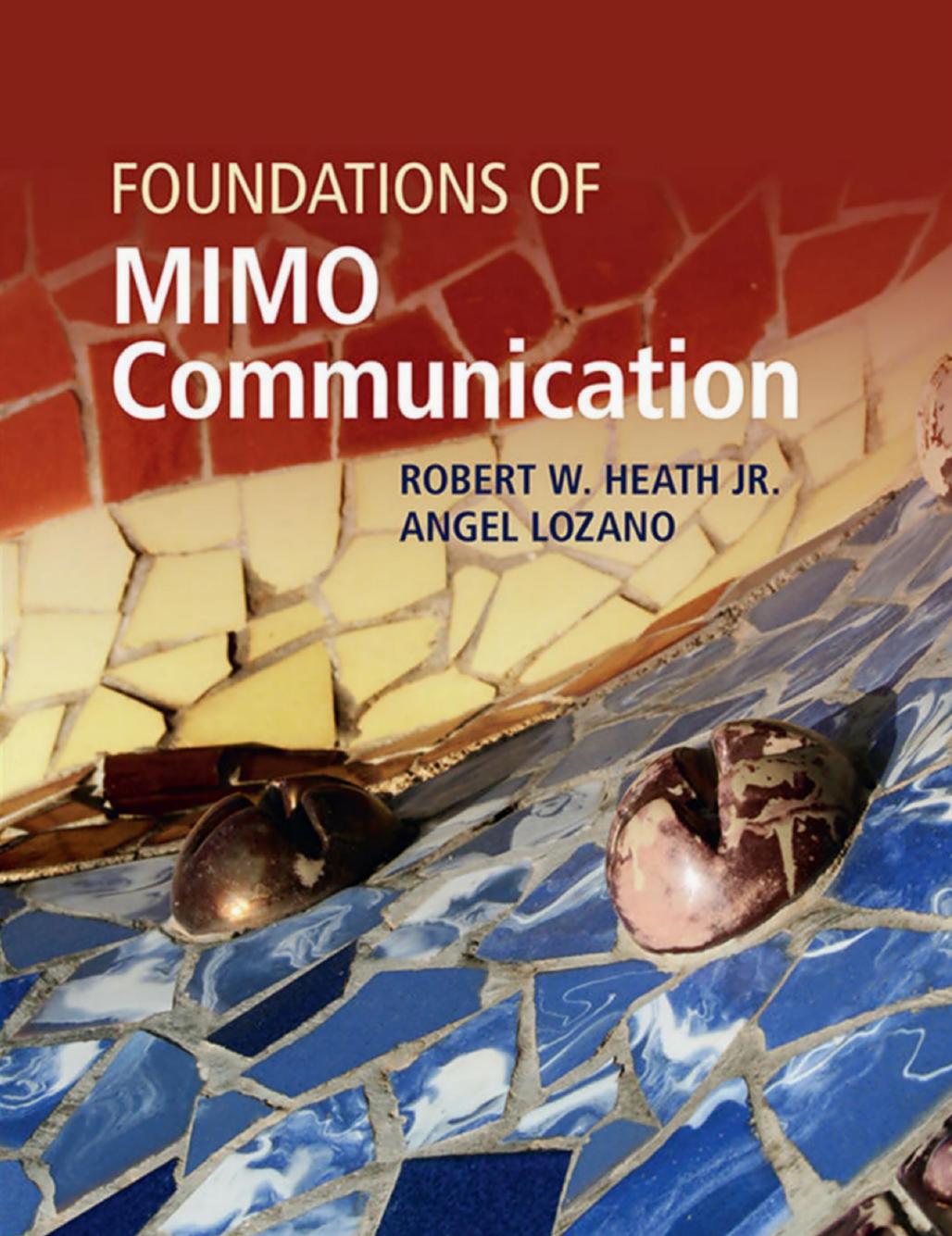Foundations of MIMO Communication 1st edition by Robert Heath , Angel Lozano ISBN 1108631134 9781108631136
$70.00 Original price was: $70.00.$35.00Current price is: $35.00.
Instant download Foundations of MIMO Communication Robert W. Heath; Angel Lozano & Angel Lozano after payment
Foundations of MIMO Communication 1st edition by Robert Heath , Angel Lozano – Ebook PDF Instant Download/Delivery: 1108631134 , 9781108631136
Full dowload Foundations of MIMO Communication 1st edition after payment

Product details:
ISBN 10:1108631134
ISBN 13:9781108631136
Author:Robert Heath , Angel Lozano
Understand the fundamentals of wireless and MIMO communication with this accessible and comprehensive text. Viewing the subject through an information theory lens, but also drawing on other perspectives, it provides a sound treatment of the key concepts underpinning contemporary wireless communication and MIMO, all the way to massive MIMO. Authoritative and insightful, it includes over 330 worked examples and 450 homework problems, with solutions and MATLAB code and data available online. Altogether, this is an excellent resource for instructors and graduate students, as well as an outstanding reference for researchers and practicing engineers.
Foundations of MIMO Communication 1st Table of contents:
Part I Wireless Communication Theory
1 A primer on information theory and MMSE estimation
1.1 Introduction
1.2 Signal distributions
1.3 Information content
1.3.1 Entropy
1.3.2 Differential entropy
1.3.3 Entropy rate
1.4 Information dependence
1.4.1 Relative entropy
1.4.2 Mutual information
1.5 Reliable communication
1.5.1 Information-theoretic abstraction
1.5.2 Capacity
1.5.3 Coding and decoding
1.5.4 Bit-interleaved coded modulation
1.5.5 Finite-length codewords
1.5.6 Hybrid-ARQ
1.5.7 Extension to MIMO
1.6 MMSE estimation
1.6.1 The conditional-mean estimator
1.6.2 MMSE estimation in Gaussian noise
1.6.3 The I-MMSE relationship in Gaussian noise
1.7 LMMSE estimation
1.7.1 Random variables
1.7.2 Random processes
1.8 Summary
Problems
2 A signal processing perspective
2.1 Introduction
2.2 Signal, channel, and noise representations
2.2.1 Passband signals and complex baseband equivalents
2.2.2 Complex baseband channel response
2.2.3 Time discretization
2.2.4 Pulse shaping
2.2.5 Additive noise
2.2.6 Energy and power
2.2.7 Channel normalization
2.2.8 Vector representation
2.3 Signal, channel, and noise representations: extension to MIMO
2.3.1 Vector and matrix representations
2.3.2 Channel normalization
2.3.3 Stacked vector representation
2.3.4 Precoding
2.3.5 Signal constraints
2.4 Linear channel equalization
2.4.1 Linear ZF equalization
2.4.2 LMMSE equalization
2.5 Single-carrier frequency-domain equalization
2.5.1 Basic formulation
2.5.2 Extension to MIMO
2.6 OFDM
2.6.1 Basic formulation
2.6.2 Extension to MIMO
2.7 Channel estimation
2.7.1 Single-carrier channel estimation
2.7.2 OFDM channel estimation
2.8 Summary and outlook
Problems
3 Channel modeling
3.1 Introduction
3.2 Preliminaries
3.2.1 Basics of radio propagation
3.2.2 Modeling approaches
3.3 Large-scale phenomena
3.3.1 Pathloss and shadow fading
3.3.2 Free-space model
3.3.3 Macrocell models
3.3.4 Microcell models
3.3.5 Picocell and indoor models
3.4 Small-scale fading
3.4.1 Multipath propagation
3.4.2 Space selectivity
3.4.3 Time selectivity
3.4.4 Frequency selectivity
3.4.5 Time–frequency double selectivity
3.5 Interlude: essential notions of antenna arrays
3.5.1 Array steering vectors
3.5.2 Array factor and beamforming
3.6 Modeling of MIMO channels
3.6.1 Analytical models
3.6.2 Parametric models
3.7 Channel estimation revisited
3.7.1 Large-scale phenomena
3.7.2 Small-scale fading
3.8 MIMO channel models in standards
3.8.1 3GPP spatial channel model
3.8.2 SUI models for IEEE 802.16
3.8.3 IEEE 802.11 channel model
3.9 Summary and outlook
Problems
4 Single-user SISO
4.1 Introduction
4.2 Interplay of bit rate, power, and bandwidth
4.2.1 Low-SNR regime
4.2.2 High-SNR regime
4.3 AWGN channel
4.3.1 Capacity
4.3.2 Discrete constellations
4.3.3 Sneak preview of link adaptation
4.4 Frequency-selective channel
4.4.1 Partition into parallel subchannels
4.4.2 Waterfilling power allocation
4.4.3 Capacity
4.4.4 Discrete constellations
4.4.5 CESM, MIESM, and EESM mapping methods
4.5 Frequency-flat fading channel
4.5.1 CSIR and CSIT
4.5.2 No CSIT
4.5.3 No CSI
4.6 Frequency-selective fading channel
4.7 Which fading setting applies?
4.8 Pilot-assisted communication
4.8.1 Frequency-flat fading
4.8.2 Pilot power boosting
4.8.3 Frequency-selective fading
4.9 Channels with interference
4.10 Summary and outlook
Problems
Part II Single-User Mimo
5 SU-MIMO with optimum receivers
5.1 Introduction
5.2 Initial considerations
5.3 CSIR and CSIT
5.3.1 Quasi-static setting
5.3.2 Ergodic setting
5.4 No CSIT
5.4.1 Quasi-static setting
5.4.2 Ergodic setting
5.5 No CSI
5.6 Pilot-assisted communication
5.7 Channels with interference
5.8 Optimum transmitter and receiver structures
5.8.1 Single codeword versus multiple codewords
5.8.2 LMMSE-SIC receiver
5.8.3 The layered architecture
5.8.4 BICM implementations
5.9 Link adaptation
5.9.1 Single codeword
5.9.2 Multiple codewords
5.10 Reciprocity and CSI feedback
5.10.1 Channel reciprocity
5.10.2 Analog feedback
5.10.3 Digital feedback
5.11 Summary and outlook
Problems
6 SU-MIMO with linear receivers
6.1 Introduction
6.2 General characteristics of linear MIMO receivers
6.3 Linear ZF receiver
6.3.1 Receiver structure
6.3.2 Output SNR distribution
6.3.3 Ergodic spectral efficiency
6.4 LMMSE receiver
6.4.1 Receiver structure
6.4.2 Output SINR distribution
6.4.3 Ergodic spectral efficiency
6.5 Relationship between the LMMSE and the optimum receiver
6.6 Summary and outlook
Problems
Part III Multiuser Mimo
7 Multiuser communication prelude
7.1 Introduction
7.2 Spectral efficiency region
7.3 Orthogonal channel sharing
7.3.1 Time-division
7.3.2 Frequency-division
7.3.3 OFDMA
7.4 Non-orthogonal channel sharing
7.5 Scalar metrics
7.5.1 Sum of the spectral efficiencies
7.5.2 Weighted sum of the spectral efficiencies
7.5.3 Equal spectral efficiencies
7.5.4 Minimum of the spectral efficiencies
7.5.5 Proportional fairness
7.5.6 Generalized proportional fairness
7.6 User selection and resource allocation
7.6.1 The proportional-fair algorithm
7.7 Low-SNR regime
7.8 Summary and outlook
Problems
8 MU-MIMO with optimum transceivers
8.1 Introduction
8.2 The multiple-access channel
8.3 Multiple-access channel with CSIR and CSIT
8.3.1 Quasi-static setting
8.3.2 Optimum receiver structure
8.3.3 Precoder optimization
8.3.4 High-SNR regime
8.3.5 Ergodic setting
8.4 Multiple-access channel with no CSIT
8.4.1 Quasi-static setting
8.4.2 Ergodic setting
8.5 Multiple-access channel with no CSI
8.6 Pilot-assisted multiple-access channel
8.7 Duality between the multiple access and broadcast channels
8.7.1 Description and significance
8.7.2 Dual versus actual multiple-access channels
8.8 The broadcast channel
8.9 Broadcast channel with CSIR and CSIT
8.9.1 Optimum transmitter structure
8.9.2 Quasi-static setting
8.9.3 Precoder and power allocation optimization
8.9.4 High-SNR regime
8.9.5 Ergodic setting
8.10 Broadcast channel with no CSIT
8.11 Summary and outlook
Problems
9 MU-MIMO with linear transceivers
9.1 Introduction
9.2 Linear receivers for the multiple-access channel
9.3 Linear ZF receiver for the multiple-access channel
9.3.1 Receiver structure
9.3.2 Output SNR distribution
9.3.3 Ergodic spectral efficiency
9.3.4 High-SNR regime
9.4 LMMSE receiver for the multiple-access channel
9.4.1 Receiver structure
9.4.2 Output SINR distribution
9.4.3 Ergodic spectral efficiency
9.4.4 High-SNR regime
9.5 Duality with linear transceivers
9.6 Linear transmitters for the broadcast channel
9.7 Linear ZF transmitter for the MU-MISO broadcast channel
9.7.1 Transmitter structure
9.7.2 SNR distribution
9.7.3 Power allocation
9.7.4 Ergodic spectral efficiency
9.7.5 High-SNR regime
9.7.6 Pilot-assisted ZF transmission
9.8 Block-diagonalization for the broadcast channel
9.8.1 Transmitter structure
9.8.2 Power allocation
9.8.3 Ergodic spectral efficiency
9.8.4 High-SNR regime
9.9 Regularized ZF transmitter for the broadcast channel
9.9.1 Regularizing term
9.9.2 Power allocation and ergodic spectral efficiency
9.9.3 High-SNR regime
9.10 Summary and outlook
Problems
10 Massive MIMO
10.1 Introduction
10.2 Going massive
10.2.1 The massive MIMO regime
10.2.2 Excess antennas
10.3 Reverse-link channel estimation
10.3.1 Pilot reuse
10.3.2 Pilot contamination
10.4 Reverse-link data transmission
10.4.1 Channel hardening
10.4.2 Matched-filter receiver
10.4.3 LMMSE receiver
10.5 Forward-link data transmission
10.5.1 Matched-filter transmitter
10.5.2 Regularized ZF transmitter
10.6 Mitigation of pilot contamination
10.6.1 Subspace methods
10.6.2 Coordinated pilot assignment
10.6.3 Reception and precoding with other-cell awareness
10.6.4 Large-scale multicell processing
10.7 Practical considerations
10.8 Summary and outlook
Problems
11 Afterword
11.1 Beyond cellular
11.2 Beyond wireless
Appendices
Appendix A Transforms
A.1 Fourier transforms
A.1.1 Continuous-time Fourier transform
A.1.2 Continuous-time Fourier series
A.1.3 Discrete-time Fourier transform
A.1.4 Discrete Fourier transform
A.2 Z-transform
Appendix B Matrix algebra
B.1 Column space, row space, null spaces
B.2 Special matrices
B.2.1 Hermitian matrices
B.2.2 Unitary matrices
B.2.3 Fourier matrices
B.2.4 Toeplitz and circulant matrices
B.2.5 Hankel matrices
B.3 Matrix decompositions
B.3.1 Eigenvalue decomposition
B.3.2 Singular-value decomposition
B.3.3 QR decomposition
B.4 Trace and determinant
B.5 Frobenius norm
B.6 Moore–Penrose pseudoinverse
B.7 Matrix inversion lemma
B.8 Kronecker product
Appendix C Random variables and processes
C.1 Random variables
C.1.1 Bayes’ theorem
C.1.2 Expectation
C.1.3 Correlation
C.1.4 Properness
C.1.5 Circular symmetry
C.1.6 Unitary invariance
C.1.7 Linear transformations
C.1.8 Kurtosis
C.1.9 Relevant distributions
C.3 Random processes
C.3.1 Stationarity
C.3.2 Ergodicity
Appendix D Gradient operator
Appendix E Special functions
E.1 Gamma function
E.2 Digamma function
E.3 Exponential integrals
E.4 Bessel functions
E.5 Q-function
E.6 Hypergeometric functions
Appendix F Landau symbols
Appendix G Convex optimization
G.1 Convex sets
G.2 Convex and concave functions
G.3 Convex optimization problems
G.4 KKT optimality conditions
G.5 Lagrange multipliers
G.6 Jensen’s inequality
People also search for Foundations of MIMO Communication 1st:
foundations of mimo communication
foundations of communication quizlet
communication foundations exam answers
organizational communication foundations challenges and misunderstandings
mimo basics


